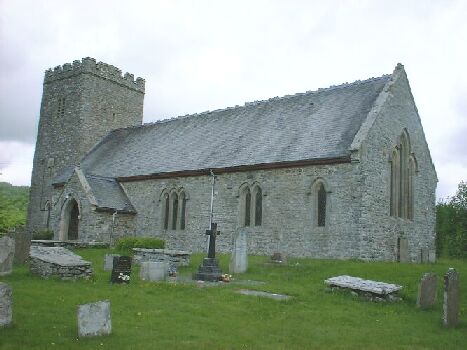
Llanafan Fawr - A Brief History
The history of the area stretches back to the Stone Age. In fact much of the area's current heritage can be traced to the Celts who arrived from their central European homeland around 200BC. They gave the area the basis of Cymraeg, the Welsh language, still widely spoken and the agrarian economy that has traditionally dominated the area. They grew plots of cereals and flax and kept sheep and oxen, often alongside a hillside encampment or Dinas.
In fact at the rear of the Red Lion public house in llanafan Fawr lies the unexcavated remains of an Iron Age Village encampment. Large circular walls surrounded by trenches guarding an inner courtyard are all that remain of settlement (Powys / SN 967566). On the site of the current churchyard which is opposite the Red Lion would have been that section of the site that was devoted to their beliefs and rituals and which is know dominated by an ancient yew tree . The tree has been dated as being over two thousand years old aand is one of the oldest in Wales. Cuttings were taken from it in 1997 to be planted elsewhere to give this venerable tree a new lease of life.
Circa 500A.D Celtic saints spread the gospel through western Britain. Where their message took root they founded simple churches, each within a consecrated enclosure. This was called a Llan. It often took the saint's name, hence Llandewi, (Llan-the enclosure of Dewi-David) the old parish church, said to have been founded by St. David (Dewi), patron saint of Wales, who died in 589AD. Many churches in the area date back to this time, 50 years or more before St. Augustine converted England to Christianity. St Afan who was one of the few true original Welsh saints, fell in battle and lies buried in Llanafan church yard. St Afan who was the grandson of Cynedda Welledig, King of Britain and cousin to St David, died trying to protect the locals from bands of marauding Vikings in the fields by Dolyfelin Farm, 1/2 a mile from the pub. A standing stone marks the spot where he fell. He was laid to rest in Llanafan church yard which then became a focal point for pilgrimages. So important a site did it become, that Llanafan church became one of the six main churches in Wales and now contains the remains of several Welsh Bishops.
The first mention of the Red Lion itself was in 1188, when a travelling monk, Geraldus Cambrensis, or Gerald of Wales, whilst recruiting for King Richard The Lion heart's crusades, travelled to Llanafan to pay respect to St Afan's remains. Whilst at Llanafan he recorded he stayed at the inn at Llanafan. Gerald also recounted a story of a hunter in the reign of Henry 1, The Hunter, one of the Lords of Radnor thoughtlessly slept overnight in the church with his pack of hounds and was struck blind for his desicretion and his hounds turned mad. The hunter lived for many years in this state, but upon making a pilgrimage to Jerusalem he was restored to sight; whereupon he went into the holy wars, and in battle with the enemies of the Christian faith, he spurred his horse and rushed boldly into their thickest ranks, thus honourably concluding his life.
The current Red Lion dates from about this period, although the original timbers clearly visible in the current building date back before this as they would have been used as ship's timbers previously. The great oak forests of the area were felled and the timbers transported to the ship yards for new ships. On the return journey the wagons would bring back the old timbers to the area where they would be used for house building. The huge cruck frame timbers of the current building would be just such recycled timber, indeed many old joints, from the timber's original employment are clearly visible.
The original building would have been single story, which explains the low ceilings. The upstairs was added in the 17th Century. The stone walls also would have been a latter addition, as the original walls would have been mud and plaster. The pub is unique in that it has remained unmodernised, mainly because it has been in the same family for over 350 years who ran and still do run the surrounding farm. The pub itself was little more than a sideline with the farm being the main business and so the great majority of the building was the working farm, with just an open cellar and small snug being given over to the pub.

St Afan's was rebuilt in 1887 as a single-chambered nave and chancel with a West Tower. Beside the new carved font is a small 13th century one. In the sanctuary there is a pillar stone with a circled cross of the 7th to 9th centuries. The Church registers date from 1720, but there are later gaps, full details can be found at the GENUKI site. Today, the church and it's yard still hold secrets including a unique gravestone noting the demise of John Price who was murdered on April 21st 1826, over sheep rights on The Darren hill just behind the pub. The gravestone not only states he was murdered but also names the murderer, an R. Lewis. Relatives of both families still live in Llanafan!
The church is located is alongside the B4358 road which runs between Newbridge and Beulah, 4 miles from both. It has the OS Grid Reference SN969557
Return to the Lewis Family Page
Return to The Main Family Home Page
This page was last updated on 24/07/02 10:06